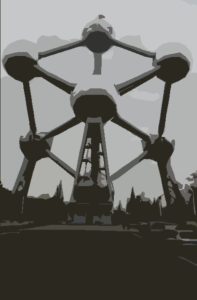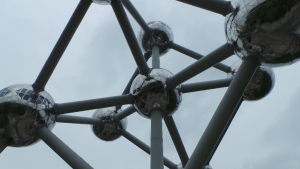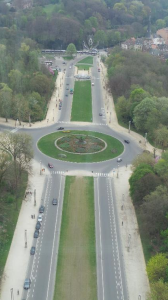It is confidently lauded as “the symbol of Brussels” on the front of the brochure, which includes photographs that look as though they were taken to promote the Atomium when it first opened for the 1958 World Fair. The Atomium was conceived as a symbol of “progress and modernity,” and is described in the Atomium Guide Book – available for free download from atomium.be – as “the most surprising, creative and astonishing building in the world.” When visiting the Atomium with my wife and daughter I wished they had been a little more creative with the toilets. We were at the top of the Atomium, enjoying the view of the parkland surrounding the building, which was the site of the World Fair and still includes the U.S. Pavilion building, and finishing our refreshments in the restaurant, when our daughter needed to answer the call of nature. There were no toilets close to the restaurant – which even the most uncreative mind would surely think is a good place for toilets – and so we walked all through the structure trying to find them. Of course, being a man, I couldn’t just ask a member of staff where to find the toilets, I had to discover them for myself; and we followed the signs for the various exhibits in the building, hoping that we would eventually come across some toilets. But the toilets didn’t materialize and after our need became a little more desperate, my wife finally asked one of the uniformed attendants where we could find a restroom.
It was then that we discovered that the toilets were close to the ticket office. This meant that we had to find our way to the bottom of the Atomium, exit the building, and then walk to another building. By the time we had finished looking – hurriedly – at the exhibits on the various levels of the Atomium and made our way down escalators, steps and elevators to the ground floor, and then had a quick look around the gift shop, I also needed the toilets! My wife and daughter had already gone on ahead, so I made my way to the other building and followed the sign for the gents. I turned the corner, seeking them out, and then I heard the voice of a man call out “bonjour monsieur.” I didn’t realize the voice was directed at me and I continued. “Bonjour monsieur” the voice sounded again, louder. Again, I didn’t realize those words were directed at me. Then after a few moments, the voice rang out again, but much louder and more insistent this time. “Bonjour monsieur,” the sound almost echoed and I finally realized he was calling me. I stopped and then walked over to the man, who was demanding 30 cents for me to use the toilet. Luckily, I had some change and I paid the man the fee. This place really was astonishing!
Despite our toilet adventure, we did enjoy our visit to the Atomium. It is certainly a unique building and I remember its picture being on stamps as a child and wanting to visit it. I probably knew it was in Brussels when I was in primary school, so it has certainly been effective in promoting the city as a destination for travelers from around the world. The Atomium was designed by Andre Waterkeyne to represent 9 atoms of iron magnified by 165 billion times. In nature, these atoms form a cubic structure, hence the shape of the Atomium. In 1958, the structure also represented hope for humankind’s future through scientific progress. One of the exhibits included some quotes from various designers that I thought were really good. For example, there was a quote from Buckminster Fuller, the American inventor and visionary, whereby he stated “When I am working on a problem, I never think about beauty. I only think about how to solve the problem. But when I am finished, if the solution isn’t beautiful, I know it is wrong.” I liked this quote because it suggests that any really good design, or any creative process really, is also beautiful in some way; or should be for it to be successful in terms of advancing humankind toward a better future. Our encounter with the Atomium made me feel that I had visited both the past and the future.
We had arrived at the Atomium on one of the open-topped hop-on, hop-off, buses, but when we got back to the bus stop to continue touring around Brussels, we found that these buses stopped running early on the day of our visit and we had, therefore, missed the last bus. It was only about 5 p.m., so we were disappointed that we would not be able to continue the city tour. Instead, we walked to the nearest Metro station and took a train to the Grand Place, the historic center of Brussels to see the baroque architecture. We took a few photos and then bought some Belgian chocolates and a few cheap souvenirs. Just outside the famous square, we found an Asian restaurant and ate noodles. Thus, our day in the “capital of Europe” ended and we headed back to the hotel.



No comments yet.